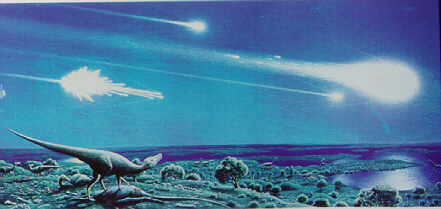Until recently, people simply knew that dinosaurs went extinct - their fossils were found throughout the Mesozoic era, but were not located in the rock layers (strata) of the Cenozoic era. So, we knew that dinosaurs went extinct some 64-66 million years ago, but that was all. Many wild ideas about how the dinosaurs were rendered extinct were presented over the years.
1980!: Few satisfactory answers to the mystery behind the extinction of dinosaurs were offered until 1980, when a group of scientists at the University of California at Berkeley planned a striking and persuasive mechanism for the "K-T extinction" (meaning the extinction of dinosaurs at the boundary between the Cretaceous period (K) and the Tertiary period (T)). Since the Alvarez hypothesis was first proposed, the search for the "perpetrator" of the K-T extinction has been a thriving area of scientific research. It incorporates scientists from many different fields together with astrophysics, astronomy, geology, paleontology, ecology, geochemistry, and so on.

Mass Extinctions: But before we dive into the complex issue of the K-T extinction, we need essential background information to understand the basics of the controversy. The "great dying", as it is sometimes called, is an example of a mass extinction: an episode in evolutionary history where more than 50% of all known species living at that time went extinct in a short period of time (less than 2 million years or so).
There were several mass extinctions in the history of life; the great dying is not nearly the largest! The largest would be the "Permo-Triassic" extinction, between the Permian and Triassic periods, of the Paleozoic and Mesozoic eras. In this obviously catastrophic event, life on Earth nearly was wiped out - an estimated 90% of all species living at that time were extinguished. But the fact is that the extinction was due to many changing global conditions at that time, but even that is not solved yet. The issue has not received much press because the dinosaurs were not involved, but another familiar group, the trilobites, was wiped out among others.
Well, about 60% of all species that are present below the K-T boundary are not present above the line that divides the "Age of Dinosaurs" and the "Age of Mammals". In fact, dinosaurs were not among the most numerous of the casualties - the worst hit organisms were those in the oceans. Large groups of organisms, including some members of Foraminifera, Echinodermata, Mollusca, and the marine Diapsida all were devastated by the K-T event. On land, the Dinosauria of course went extinct, along with the Pterosauria. Mammals and most non- dinosaurian reptiles seemed to be relatively unaffected.